The Dangers of the Russian Manicure
by Ana Seidel, Vitaly Solomonoff & Doug Schoon
Have you ever heard the expression, “The world is getting smaller?”
It’s true.
But…
The internet has become a double-edged sword.
We learn really amazing things from people we will never meet physically. Our lives are improved immensely.
But… we also learn really dangerous and destructive things. The “Russian” manicure is a technique that could cripple the global nail industry.
In this article you will learn:
-
- Why the Russian Manicure is considered a medical procedure
-
- What the skin looks like microscopically after electronic bits have been used to “buff” the skin
-
- Why this manicure practice permanently damages the nails of over 90% of clients who receive this treatment
-
- Global statistics revealing how the popularity of this deceptive manicure process will permanently deform the nails of millions of people.
- And how to protect yourself today
The Hidden Dangers of the ‘Russian’ Manicure
By Vitaly Solomonoff – Dermatologist, Cosmetic Chemist, International Nail Judge and Author.
‘Beauty is pain’ is the well-known quote from Voltaire’s play, La Bégueule (the prude woman). This manifests when women are ready to sacrifice everything on the journey to aesthetic perfection.
The Russian (Dry, Machine, E-file) Manicure Defined
The ‘Russian’ manicure—a variation on high-speed microdermabrasion with e-files, is seen as an effective contemporary method of removing unwanted living skin as part of the preparation process of a nail service.
It is seen to negate the need for clipping, removers or wooden sticks. However, there are many concerns surrounding this method.
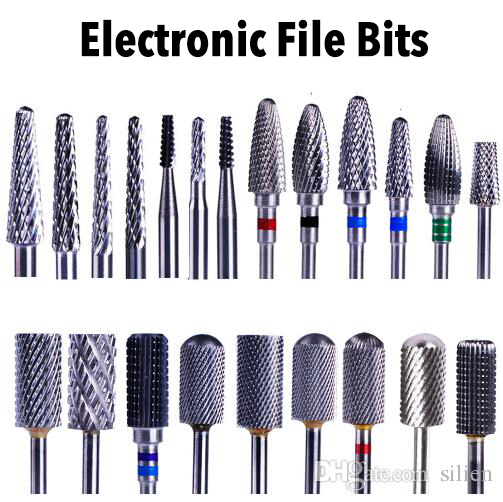
The Function of the Matrix
Frankly speaking, we should not remove living skin surrounding the nail plate at all. The only exception would be in cases when excessive skin or hangnails can become a source of infection.
The skin is a secure and strong guard to the most sensitive and fragile structure—the nail matrix, which is the only layer of germinative cells. This is the innermost layer of the epidermis from which new tissue is constantly formed.
The function of the matrix is to produce keratin, the main substance of the fingernail. The nail matrix is so sensitive that factors of temperature, insignificant pressure, minor injuries, and skin damage lead to inflammation. These external factors may impact the formation of the normal healthy keratin in the nail plate.
There are also plenty of internal factors, such as health and skin conditions which can influence the process too. These factors include diabetes, psoriasis, and lung disorder, just to name a few.
The incorrect synthesis (creation) of the nail keratin always results when the nail grows. Changes in shape, structure, texture, color or even separation from the nail bed (onycholysis) are all symptoms of damage to the matrix.
The sad news is that all of these results are unpredictable yet can be seen immediately or months after chemical, biological, or mechanical traumatisation.
Everything we see on our nails is the result of the matrix’s function. In fact, when we talk nails we should consider the matrix.
Three Year Study – Shocking Permanent Damage
Two years ago, my team completed the study of more than 300 cases of volunteers who regularly undertook a manicure using this technique.
The study continued for 38 months (over 3 years) before we came to shocking results.
We found 91% of volunteers suffered symptoms of a damaged nail matrix or nail bed!
Symptoms included all signs of matrix/nail dystrophy from splitting, horizontal ridges, and slow nail growth.
Extreme cases reported painful neuropathy (nerve damage) and high sensitivity.
Less than 9% of cases were determined as safe and ‘successful.’
It was also discovered that infectious inflammation is a common issue with clients who have a compromised immune system—diabetes, etc.
This type of inflammation occurs even when the manicure is performed with sterilized implements.
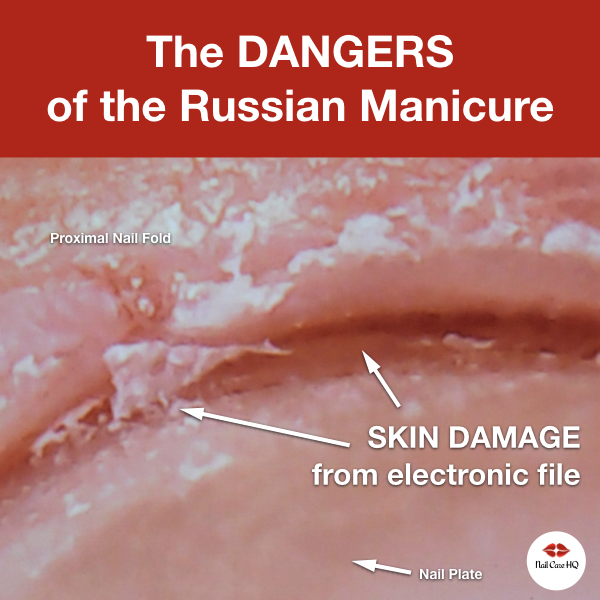
Immediate Damage
Microscopic cracks in the skin that are done during this type of manicure are inseminated with microflora during the few hours after the procedure. After analysis, we concluded that the source of danger from using this technique includes:
- Vibration – Even imperceptible vibration injured cells and induces the local immune response.
- Traumatisation – Damage, over filing or invisible (to the naked eye) micro-injuries even when a nail tech is sure his/her technique is controllable.
All together, vibration and traumatization induce acute or chronic inflammation and a syndrome of repetitive trauma, which leads to nail dystrophy.
Do We Need Inflammation?
Did I mean ‘inflammation’ earlier? Yes, it was not a figurative expression.
We get used to thinking inflammation is something unpleasant, painful and related to infection.
Actually, inflammation is not a symptom of infection, but a part of the human immune response and is a protective reaction. It occurs every time living cells—and sometimes dead ones—are damaged.
The injured cell releases an alarm signal in the form of special molecules—cytokines. Then immune cells get a call, and with blood flow travel to the place where the organism has been injured.
The Good, the Bad, and the Ugly
Along with the local immune cells, the cytokines begin a real battle against physical agents, chemical agents, or microorganisms.
Normally, inflammation leads to the healing and renewal of the tissue.
However, inflammation may end with either a positive or negative outcome.
- Positive effects used in many cosmetic procedures from chemical peels to pedicure initiate this reaction to renew skin.
- Negative effects include ineffective inflammation. For instance, micro-organisms overcoming the battle or when the process turns into prolonged or chronic inflammation. The two factors of inflammation, cytokines, and toxins, continuously attack normal tissue preventing tissue repair.
Acute inflammation is usually a short-term reaction accompanied by redness, itching, swelling, and pain.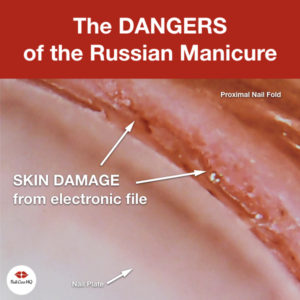
Chronic inflammation may be invisible at the start and followed by deformity of the organs or tissues. Chronic inflammation can only be observed over time.
This is the case with the “Russian” manicure. The matrix area, nail bed, and surrounding skin are receiving constant, repetitive traumatization.
This repetitive trauma causes chronic inflammation does not allow for physiological tissue recovery.
The turnover cycle of skin is approximately 30 to 35 days. However, manicures can be performed more frequently.
It’s no wonder that this technique leads directly to various nail symptoms and undesirable conditions. Many symptoms are postponed and become evident only months after a single procedure.
Long Term Damage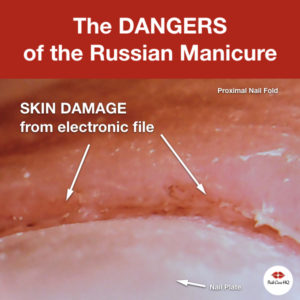
The constant mechanical attacks performed on the top layers of skin pass alarm bell messages to underlying cells of the nail matrix. The chemical language of cytokines activates the immune system response.
Consequently, the frequent activation of the local immune system means chronic inflammation, which in turn affects matrix cells.
Education Matters
A deep understanding of the processes in live skin helps us develop correct techniques for any manicure system.
This requires special knowledge, training, and understanding of what happens to the skin and nails while under attack from the vibrating, sharp bits of e-files.
Regrettably, we have NOT found a safe mode for this technique.
E-files are magnificent tools so let’s use them for important occupations, not the manicure. In improperly untrained hands, e-files can be very dangerous.
Knowledge and advanced education are the ONLY way to make this service completely safe.
Let’s argue with Voltaire and prove it to our clients—beauty can be painless.
(Reprinted with permission from the author, Vitaly Solomonov and ScratchMagazine.co.uk)
The Russian Manicure Can Lead to Permanent Damage
By Doug Schoon, Internationally-recognized scientist, author and educator
We want everyone across the globe to be aware of the problems of the “Russian Manicure”.
Someone commented on my Facebook page about their concerns that many will not heed the warnings from experts and I agree.
Hopefully, this problem may be self-correcting.
When people who use these methods start seeing the reported problems associated with these types of manicures, hopefully, they’ll take notice and stop this dangerous practice.
Like Vitaly wrote, symptoms people will see or experience are:
- Excessive damage to the skin around the nail plate
- Excessive regrowth of hardened callus-like tissue
- Redness
- Pain
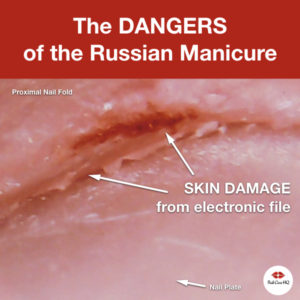
- Puffiness
- Weeping
- Water-blisters
- Itching
- Allergies
Not only can this method cause the expected hardening and rapid/excessive regrowth of tissue, but the damaged skin is also more likely to develop infections.
Product-related skin irritations or allergies are more likely as well.
Invaders beware—watch closely for these issues—and don’t blame the products.
Blame your techniques.
I’m already hearing of, and seeing these problems.
One of the biggest problems in the nail industry is that too many nail educators are teaching misinformation they learned in the past. They have NOT kept up with their education.
And… it’s getting worse, not better.
Pseudo Fame
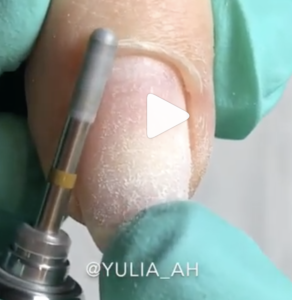 Many people teaching this manicure preparation technique are well-known artists. Some mistakenly believe they know what they are talking about—but often they do not.
Many people teaching this manicure preparation technique are well-known artists. Some mistakenly believe they know what they are talking about—but often they do not.
These educators are harming the nail industry with every class they teach!
Just because someone can bling out a nail, doesn’t mean they have a real understanding of the nail or using products and are following the manufacturers’ instructions.
“Internet famous” does NOT mean “knowledgeable”. It only means that they are artistically skilled.
There is a big difference! Don’t be fooled.
Sterilizing Is Not Enough
There is a potentially dangerous myth stating that sterile implements or electronic bits can’t cause infections.
What? Of course they can.
The “Russian Manicure” is considered an invasive manicure. Invasive manicures are prohibited in many states, provinces or countries because they damage skin and make it significantly more susceptible to infections.
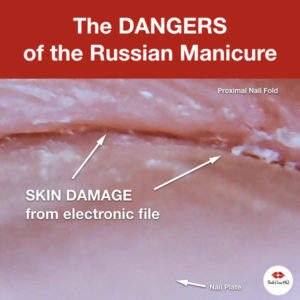 This infection risk can last for many hours and perhaps for several days. The skin will remain susceptible to infection until the damage heals.
This infection risk can last for many hours and perhaps for several days. The skin will remain susceptible to infection until the damage heals.
Cutting the skin that borders the nail plate increases the client’s risk of infections, even after they leave the salon. I recommend that you don’t do this.
Someone told me, “Well, I’ve never heard of that happening”.
Of course not! Who would openly admit they cut their clients skin around the nail plate and cause an infection? Yet, I’ve seen this occur many times!
A Medical Procedure
The use of an e-file to smooth, buff, or abrade the skin around the nail plate is considered microdermabrasion.
Many states in the United States of America restrict the use of the files to only the nail plate. Other states require special medical licenses.
In many places, nail technicians are not allowed to perform these services.
Check your local regulations and with your insurance company. This technique may not be covered by your insurance policy and can put you in serious financial risk.
Even calluses should not be completely removed from the skin due to the increased risk of infection.
Is It Worth An Arm Or A Leg?
The skin on the feet or palm of the hand is many times thicker than the nail fold surrounding the skin.
Infections in the skin around the fingernail can quickly spread to bone and result in amputation of a finger or hands.
This is not speculation!
It happens far too frequently and is a problem the nail industry must solve.
Manicures should be safe and not endanger the public’s health.
NEVER intentionally cut or abrade the skin around the nail plate. That’s trouble waiting to happen.
Permanent Allergies?
It is even more foolish to place UV gel manicure products or other nail coatings directly against this damaged skin.
Damaged skin is far more likely to become irritated or develop permanent allergies to nail products. More trouble is waiting to happen. Don’t do it!
Protect the skin around your clients’ nails. Don’t invade it.
Educate your clients about the risk of any invasive procedures and advise them against letting anyone cut or abrade this thin and sensitive tissue.
Be Proactive!
I’ve published “Nail Structure and Product Chemistry”, as well as a series of three books called “Face-to-Face with Doug Schoon”, Volume 1-3.
I’m a nail scientist. My books are factual and based on scientific and medical research.
My opinion is based on over two decades of experience studying nail salons, products, services, and common practices.
Sadly, most nail technicians do not bother to read my books, which is why we are in this education mess.
The facts are there for those who want to learn them.
Knowledge is Power
In my view, if you are a nail educator, you MUST read all three of my “Face-to-Face with Doug Schoon” books or it is highly likely you’re are teaching misinformation.
This means you are part of the problem.
If you are a consumer, learn what procedures are dangerous and don’t let a nail technician hurt you. You are the best advocate for your body.
Global Access
My books are easy to read and understand, so please help to be a part of the solution and save the industry from sinking any deeper.
These books are available around the world from Amazon, iTunes, and available in the Nook and Kobo formats. They are available as both printed and e-books. They are low cost, and easy to get.
Please read them. You are responsible to provide healthy and safe manicures to your clients.
The Ultimate Test
Before you consider taking a class from ANY nail educator FIRST ask them… have you read all three volumes of “Face-to-Face with Doug Schoon”?
Reprinted with permission from Doug Schoon
Global Statistics for 2017
As you’ll read below, the most startling information is how many countries do not require licensing.
This means that ANYONE can start a nail career with no training!
Educators are going to other countries teaching nail techniques without licenses to teach in those countries.
UNITED STATES
- Market Size: $8.53 billion
- 56,386 nail salons
- 439,751 nail professionals, 31% don’t work in a salon
- Ethnicity: 36% Caucasian, 56% Vietnamese, 8% other
- Licensing: Required in all states, except Connecticut
CANADA
- Market size: $5 billion (hair and nail salons)
- Licensing: Only in Manitoba, New Brunswick, and Nova Scotia, though outside of these jurisdictions some aspiring techs do still opt for formal education and training
MEXICO AND CENTRAL AMERICA
- Market size: $138.2 billion (estimated between 2014 and 2020 for South America, Central America, and North America)
- Licensing: Varies by country, but typically minimal or nonexistent
UNITED KINGDOM
- Market size: Annual beauty spending is £876 (US$1,270) for women and £711 (US$1,031) for men
- Licensing: Inconsistent — some parts of London require licensing but each council makes its own rules; no government licensing outside of London
GERMANY
-
- Market size: €2.5 billion (US$2.8 billion)
- Licensing: None for manicures or pedicures; cosmetologists (hair and skin professionals) and podiatrists (those who specialize in the health of feet) do have licensing requirements
SOUTH AFRICA
- Market size: R25.3 billion (US$1.9 billion) for all cosmetics and personal care together
- Licensing: No government licensing; many nail schools but no standard curriculum
RUSSIA
- Market size (beauty): USD$14.6 billion (RUB 555.1 billion) in 2014
- Schooling: Certificate of Training Completion earned from nail school; no license required
INDIA
- Market size: $3.5 billion in 2015 (all professional salon services combined)
- Licensing: None required by the government; multinational organizations and nail brands offer their own certifications via designated training facilities
AUSTRALIA
- Market size: $541.2 million
- Schooling: Nail courses available at beauty schools but many nail professionals are self-taught; no government licensing
JAPAN
- Market size: 160 billion yen (US$1.4 billion)
- Licensing: Private licensing via Japanese Nailist Association and nail manufacturers; no government licensing
VIETNAM
- Market size: 931,000 VND (US$42) average annual per-woman spending on beauty services (includes hair, skin, eyebrows, nails, and other professional beauty services)
- Licensing: No government licensing; some schools issue certificates upon graduation
Statistics Source: NailsMag [https://files.nailsmag.com/Handouts/NABB2017-18stats-LR.pdf]
In Conclusion
We only get one body and it’s our responsibility to care for it through the decades.
We make choices daily that are healthy or destructive to our health and wellbeing.
And, we live in a world now where we can be educated and influenced by people all over the globe.
Primum Non-Nocere
First, do no harm…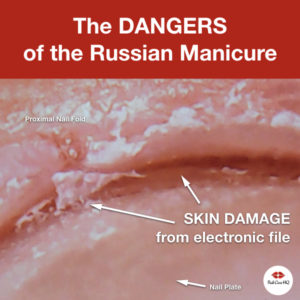
As you’ve learned in this article, there are certain nail care and nail enhancement processes that should be done by nail professionals.
Others should only be done by medical professionals. The “Russian Manicure” is microdermabrasion and is a medical procedure.
As a nail professional, you are responsible to learn and practice safe nail care and enhancement techniques.
Your clients’ nails change over time.
As an artist, you are only as good as the canvas you prepare. Are you doing it right?
Are you adapting as new medical knowledge is discovered about nails?
There is a phrase in medical education which often gets aired at the welcoming lecture to medical school: “50% of what we teach you over the next five years will be wrong, or inaccurate. Sadly, we don’t know which 50%” [Source: Blog Postgraduate Medical Journal ]
Product chemistry changes over time.
Are you learning from the product manufacturers regularly? What you learned in nail school may be very out of date.
You have a responsibility to take continuing education courses to stay at the top of your field.
You owe that to the health of your clients’ nails.
Caveat Emptor
Let the buyer beware…
As a consumer, you are responsible to know what nail preparation procedures will harm your body.
Now it’s necessary to educate yourself.
You know the names and functions of your muscles, bones, and internal organs. You need to know the names and functions of the parts of your nails.
You decide with your money.
Do not exchange your hard earned money to let someone potentially permanently damage your nails.
If it hurts, make them stop. If you bleed, make them stop.
Do not let a nail professional hurt you because you “don’t want to hurt their feelings.”
And, do not assume that they are doing things because “they have more education.” A lot of them don’t.
Since the world is getting smaller, we owe it to ourselves and each other to keep it safer.
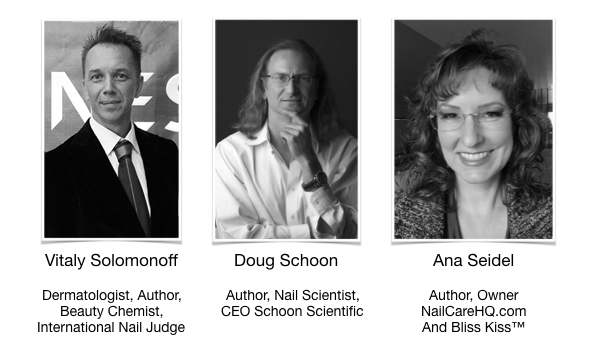
If you liked this article . . . please share!
Follow Us on Instagram
Join the Blissette💋Nail Bar
Engage. Connect. Create. Laugh. Uplift. Find Your Nail-Obsessed Tribe!If you love nails, polish, nail art, YOU BELONG AT THE BLISSETTE NAIL BAR!
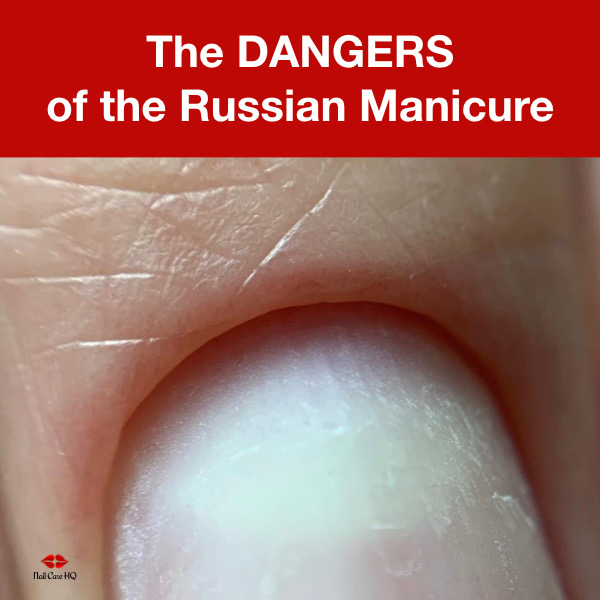
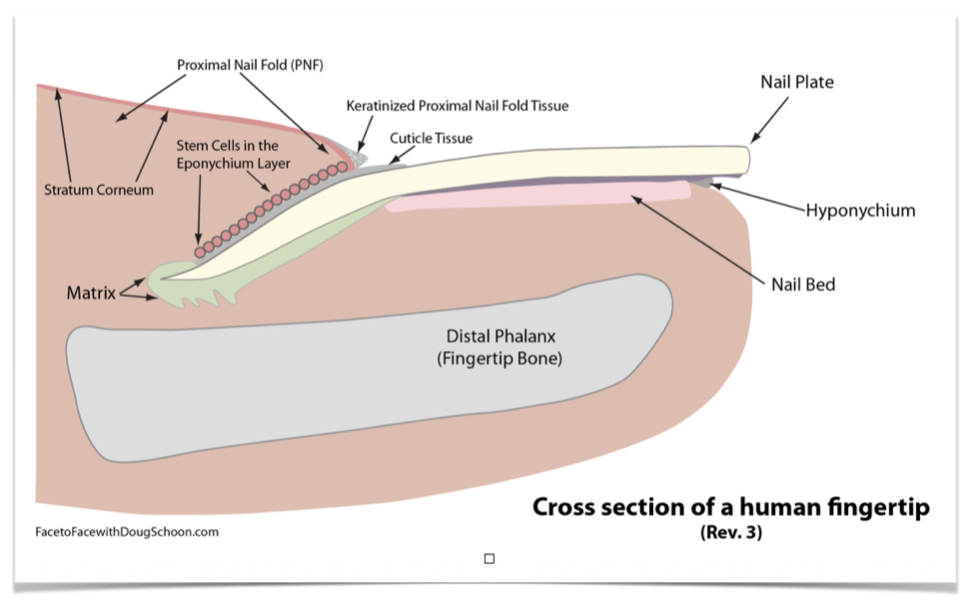
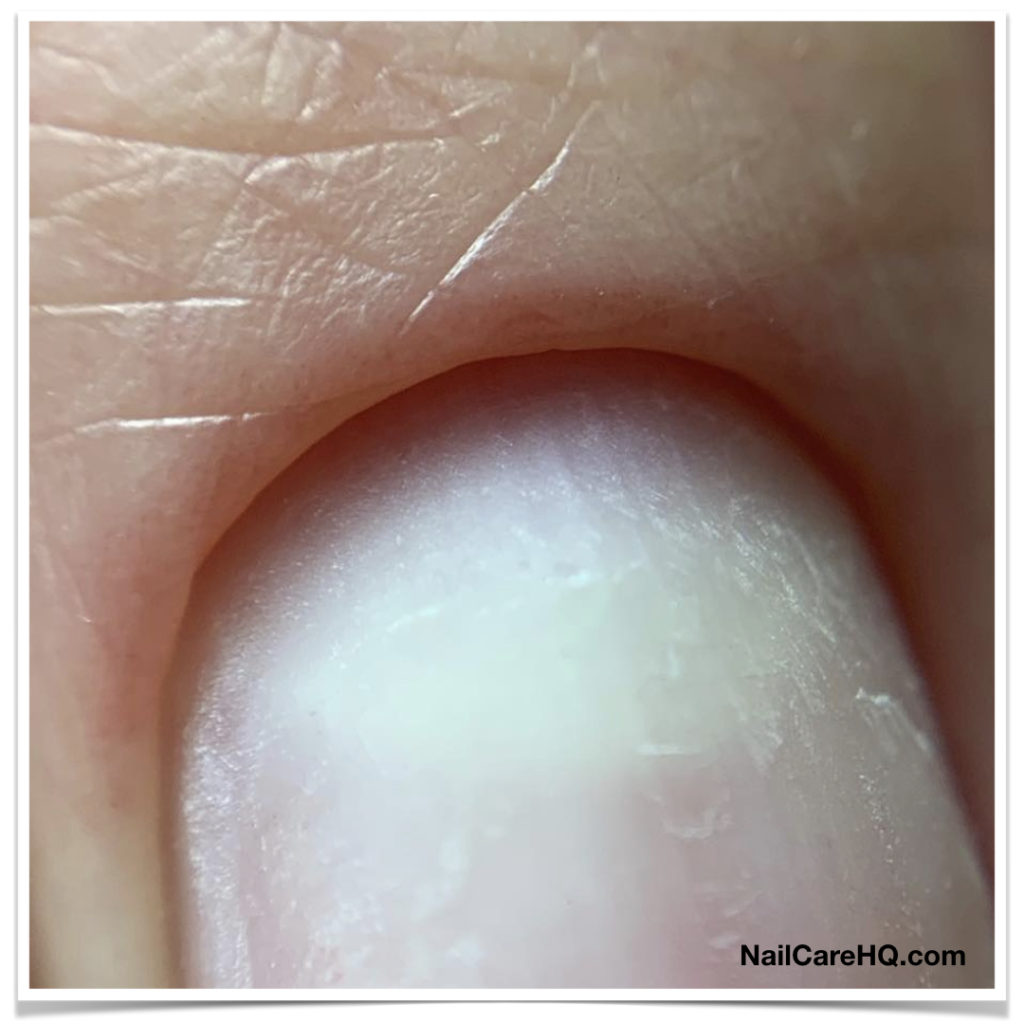
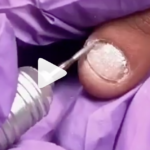
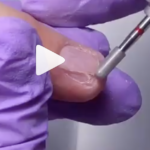
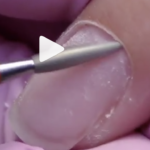
0 Comments